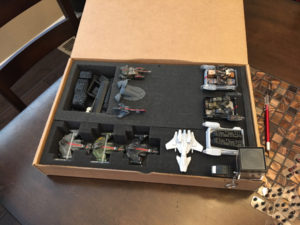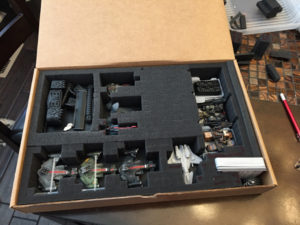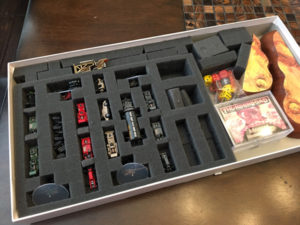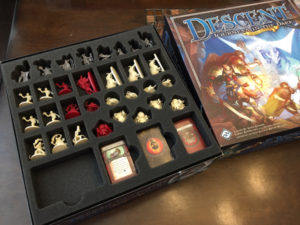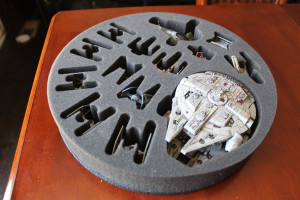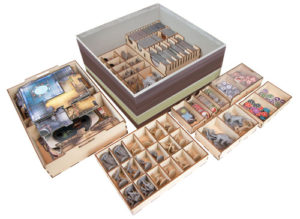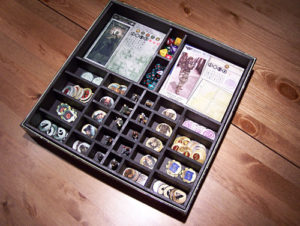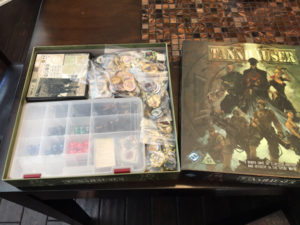I picked up some pluck foam the other day so that I could finally properly store my Dropzone Commander minis and it got me thinking of game storage solutions and where we are in the industry.
Pluck foam is a pretty common way to store miniatures and protect them during travel. It is pretty inexpensive for foam and is infinitely customizable because the entire middle section is scored into tiny squares. These squares can then be cut and pulled out in the rough shape of your model. As you can see from the image above, I’ve already started cutting the foam out to fit my Dropzone models and I have some more models and accessories laid out to help plan the layout for the rest of the box.
After a bit more cutting and pulling, I was able to finish out the main models. During this process, I like to maximize the space so I create some thin walls separating the models. This makes the walls somewhat fragile so I take some white glue and tack down the walls to keep things more stable.
I used pluck foam to also store my pimped out copy of Thunder Road, showing that foam storage solutions aren’t just for table top minis games
Pluck foam isn’t the only option to store minis. Staying with the advantages that foam provides (soft protection, light weight, and great customization), you can spend a bit more and work with custom foam cutting companies like Battle Foam to pick up really nice foam trays that are specifically cut for your models.
I like to keep my game boxes and companies like Battle Foam tend to want to sell you their bags as well but recently, these companies are catering to the board game market and offering custom foam trays that fit the game contents and the box they come in. Above, I have an example of a foam tray set for the Fantasy Flight game, Descent: Journeys in the Dark. Even though I don’t have these minis painted (maybe someday…), the storage trays work well to keep the minis and the cards/components separated. This helps in set up and tear down time and protects the minis from getting bent up or possibly broken.
Specific storage trays for a game are great but Battle Foam also offers the ability to customize the tray and even your specific model shape through their custom tray app on their site. I’ve used this several times with great results for my X-wing Miniatures Game collection. Most notably, I’ve used it for my custom Millennium Falcon carrying case.
This option is likely the most expensive foam option available but the results are great if you have a highly customized project you want to protect.
Foam isn’t the only option out there, of course. Recently, new ground has been made in laser cutting and these manufacturers are getting into the game. Companies like Broken Token are now making full storage solutions for board games by producing custom cut boxes and organizers made of 1/8″ or 1/4″ birch wood.
While I don’t have any of these products specifically, I have some friends who swear by them. The advantage these laser cut organizers have is their rigidity and size configurations, which allow the designers to set up organized trays that can be simply pulled out of the box and set up next to the board for instant game set up.
Like the custom foam options, these laser cut organizers can be some of the most expensive options out in the market today, sometimes costing as much as the game itself.
Another alternative is to create tray organizers similar to the laser cut options by cutting all the material out using foamcore.
Boardgamegeek user Maxime Verrette created the intricate example above with foam core for his Tannhauser game. It is likely the cheapest option out there and has all the benefits of the pricey laser cut options with the exception that it takes a lot of careful work.
In my last example, I cheap out completely and pick up one of the favorite options for boardgamers: Plano organizers (typically for fishing tackle boxes). This option has been around for years and is one of the favorites because it is cheap, easily accessible, and very durable.
Since the Plano boxes come in a variety of sizes and configurations, you can usually find a box that will work for the game you are trying to organize. These storage boxes can also be customized but you’ll likely need something more powerful, like a dremel, to carve out the plastic or cut out the walls you need to fit the larger pieces you intend to store. Combine this option with plastic baggies and you have an extremely budget-conscious storage and organizing solution.
As you can see, when storing your prized gaming components, there are a variety of options. Each of these options have pros and cons and it’ll be up to you to decide what works best for the game you are hoping to protect and store.

